

Utah Strawberries: Consumer Preferences for Specialty Labels
Kynda Curtis, Professor and USU Extension Specialist, Department of Applied Economics
Makaylie Langford, Research Assistant, Department of Applied Economics
Introduction
Highlights
Consumers are often willing to pay premiums for products featuring specialty labels, such as “locally grown,” “organic,” “GMO-free,” etc. Consumer preferences for foods featuring these specialty labels are often motivated by perceived environmental benefits, safety, health attributes, and appealing qualities like taste and freshness (Cappelli et al , 2022; Gundala & Singh, 2021; McCurdy, 2022). For example, consumer preferences for locally labeled foods are associated with quality considerations, local community support, and perceived freshness (Grebitus et al., 2013; Darby et al., 2008). Local products, in particular, promote community support by reinvesting money into local communities (Capelli et al., 2022). Similarly, consumers associate organic foods with perceptions of environmental quality and food safety, health, and better overall quality compared to conventionally produced food (Yazdanpanah et al., 2015; Loebnitz & Aschemann-Witzel, 2016).
• Consumer preferences for locally labeled foods are associated with quality considerations, local community support, and perceived freshness.
• Understanding consumer preferences enables growers to take advantage of premiums.
• Emphasizing “locally grown” may be more effective than focusing solely on organic.
Understanding consumer preferences enables growers to take advantage of the premiums associated with differentiated products. Additionally, policymakers can use these findings to develop programs aligned with emerging consumer preferences, promoting the implementation of food certification initiatives.
This fact sheet is the second of two discussing the results of a study on consumer preferences and willingness to pay (pricing) for fresh strawberries. This fact sheet highlights how specialty labeling influences consumers’ perceptions and willingness to pay. The study was conducted at Utah State University (USU) in August 2024. A total of 116 study participants were recruited through emails, flyers, and off-campus efforts. All participants completed a sensory taste test for six strawberry samples and an auction to elicit their willingness to pay for each sample, followed by a survey. The survey included questions about their demographics, shopping habits, and familiarity with and beliefs about several specialty production and labeling programs.
Participants were asked to rate six strawberry samples labeled as conventionally produced, certified organic, production method unknown, not locally grown, locally grown, and origin unknown. Each sample was rated based on color, size, firmness, taste, and overall acceptability. Participants were also asked if they wanted information on the specialty labeling programs. Of the 116 participants, 74 requested additional information, while 42 opted out. Thus, two-thirds (64%) of the participants were in the yes information group and the remainder (36%) were in the no information group.
Results Overview
Familiarity With Production and Labeling Programs
Participants were asked to rate their familiarity on a scale of 1 to 5 (not at all familiar to very familiar) with five specialty labeling and/or production programs. As shown in Table 1, the no information group reported greater familiarity with all production and labeling programs, potentially explaining their decision to decline additional information. The largest difference was familiarity with Utah’s Own™ program, where the no information group ranked their familiarity two-thirds higher than the yes information group. Overall, all participants lacked familiarity with any of the labeling programs, but organic was the highest rated.
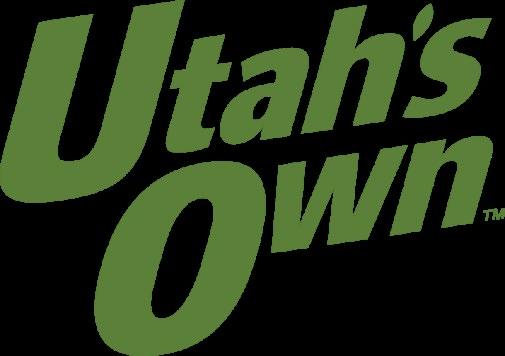
Image is used with permission, courtesy of Utah’s Own
Table 1. Participant Familiarity With Specialty Production/Labeling Programs (Scale of 1 to 5)
Organic production and labeling standards
Locally grown/sourced labeling standards Genetic modification and non-GMO labeling standards
Natural production and labeling standards
Participants were asked about their consumption habits of foods with specialty labels (see Table 2). Just under 40% of all participants consumed foods with specialty labels once a month or less, while another 9% never consumed such foods. A higher proportion of the no information group consumed such foods several times a week, again perhaps demonstrating they were more familiar with these programs.
Table 2 Participants Consumption Frequency of Specialty Labeled Foods
How often do you consume foods with specialty labels such as organic, locally grown, GMO-free, natural, grass-fed, free-range, etc.?
times a week
Perceptions of Local and Organic Food
To evaluate consumer perceptions or attitudes about specialty labeling foods, study participants were asked to indicate their agreement on a scale of 1 to 5 (strongly disagree to strongly agree) with several statements about organic and local products. For organic foods (see Table 3), participants agreed more than organic foods were too expensive and that they were not important to them. However, they did agree that organic foods were safer than conventional. Between the two groups, the largest gap in perception pertained to the statement that organic foods are healthier than conventional, which the yes information group rated higher. While differences were less significant for other statements, the yes information group generally agreed more with positive statements than the no information group.
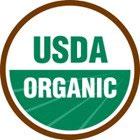
3. Participant Perceptions of Organic Foods (Agreement on a Scale of 1 to 5)
Organic products are healthier than conventional products. Organic products are fresher than conventional products. Organic products are safer than conventional products. Organic products taste better than conventional products. Organic products are too expensive.
The selection of organic products isn’t good. Organic products are not important to me.
For the local foods (see Table 4), all participants agreed most that local foods benefit local farmers and are fresher than non-local. There was also strong agreement that local fruit tastes better than non-local. Participants’ agreement with statements about local products showed the greatest disparity for the statement “Local products are too expensive,” with the no information group rating it higher than the yes information group. The yes information group showed stronger agreement with statements that local foods are fresher and benefit local farmers.
Differences in agreement between the two groups were greater for statements about organic products than for statements about local products. Both groups showed higher agreement with positive attributes of local products compared to organic products, suggesting that emphasizing local may be more effective than only focusing on organic production.
Local products are healthier than non-local products.
Local products are fresher than non-local products.
Local products are safer than non-local products.
Local fruit tastes better than non-local fruit.
Local products are too expensive
The selection of local fruit isn’t good
Local products are not important to me
Local products benefit local farmers
Table
Table 4. Participant Perceptions of Local Foods (Agreement on a Scale of 1 to 5)
Strawberry Sensory Rankings and Bids
Study participants were asked to taste and rate six strawberry samples on four characteristics and an overall rating. The ratings ranged from highly unacceptable (1) to highly acceptable (7). Results for overall ratings are shown in Figure 1. The locally grown and organic samples were rated the highest overall followed by the production methods unknown sample. The no information group rated locally grown strawberries the highest, while the yes information group preferred the organic strawberries. The greatest disparity between the two groups was for the origin-unknown strawberries, which the no information group rated much higher than the yes information group. The not locally grown sample received the lowest ratings from both groups, again demonstrating the importance of local labeling.
1. Participant Taste Ratings (Scale of 1 to 7)
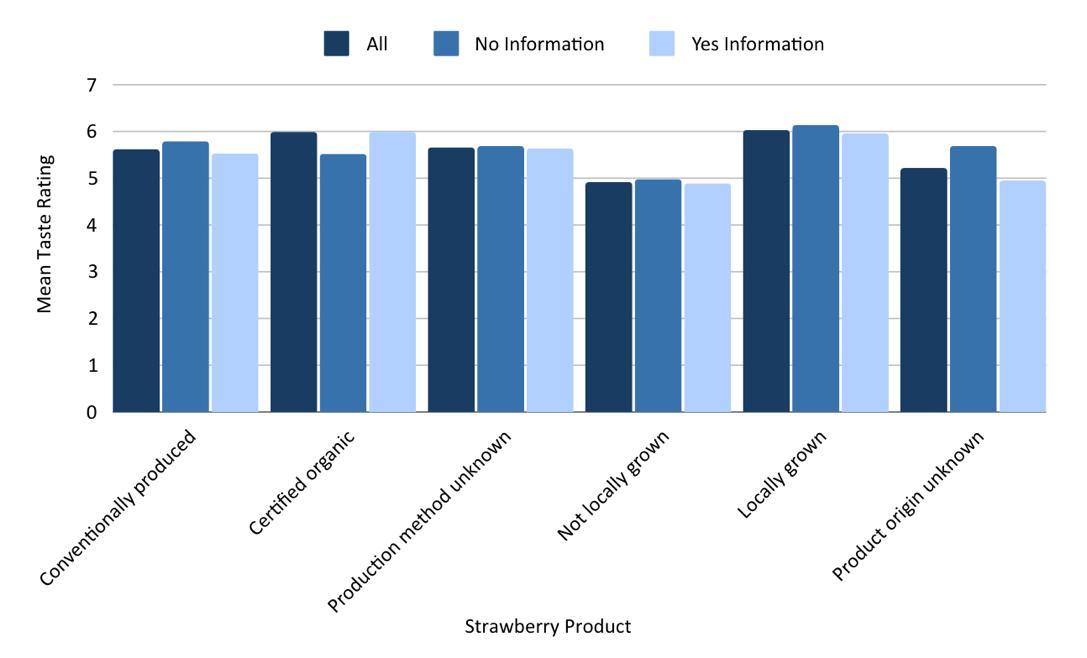
Study participants took part in a virtual auction in which they indicated their highest bid for each of the six strawberry products. As shown in Figure 2, both groups bid the highest for locally grown and certified organic strawberries. However, the no information group was willing to pay the most for the locally grown strawberries, and the yes information group was willing to pay the most for the certified organic strawberries. The largest difference in bids between the two groups was for the origin-unknown strawberries, where the yes information group was willing to pay much less than the no information group. As strawberries often top the “Dirty Dozen” (LaMotte, 2024) list of products with high levels of pesticide residue, consumer preference for organic versions is understandable, especially for those knowledgeable about organic labeling and production standards.
Conclusions
Study results show consumers are willing to pay more for specialty labeled fresh strawberries. Despite receiving additional information on specialty labeling programs, the yes information group reported lower price points than the no information group. While this might suggest that providing consumers with additional information is ineffective, the no information group reported greater familiarity with all the labeling and production programs evaluated.
Figure
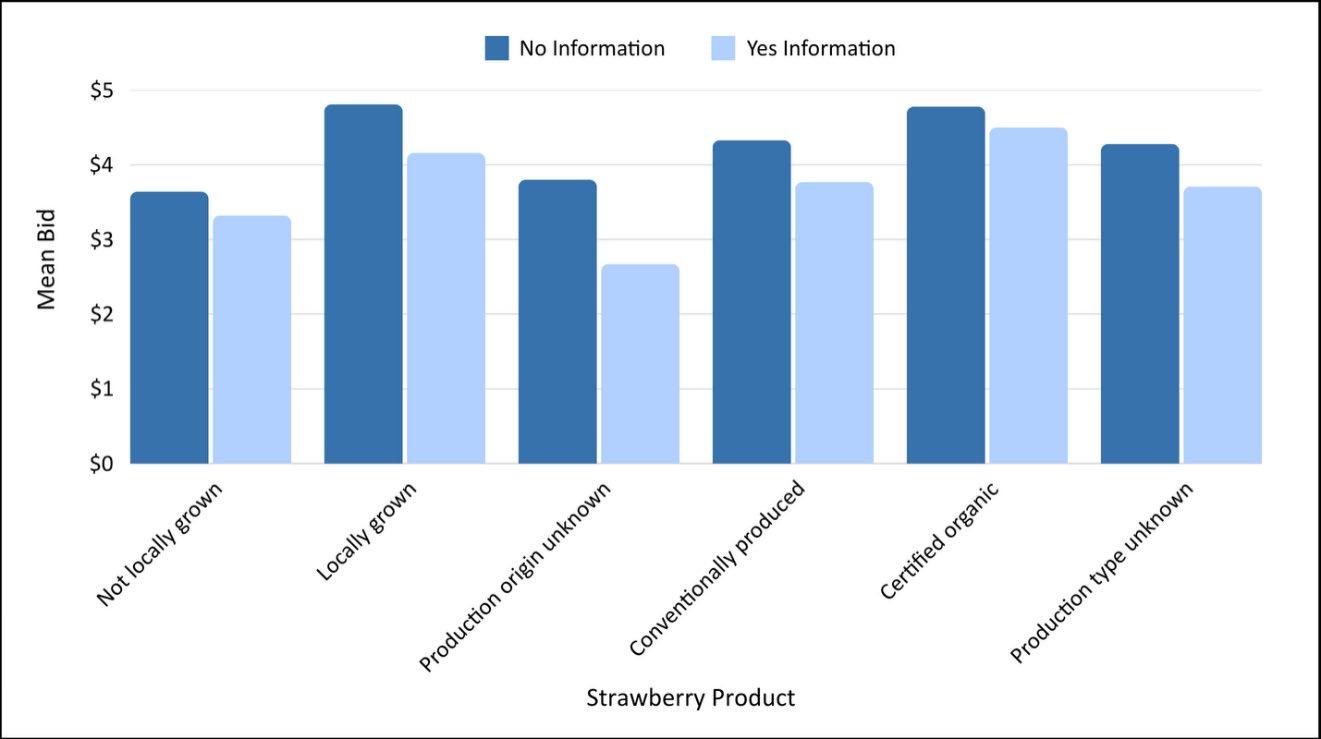
These findings indicate that consumers who are more familiar with product label attributes are willing to pay more for strawberries featuring these labels However, a single instance of additional information may not be sufficient to drive consumers to pay premium prices for strawberries. Repeated consumer education and targeted marketing efforts may be necessary to see significant increases in willingness to pay. Furthermore, since both groups agreed more with positive statements about local products compared to organic products, producers may benefit more from focusing their marketing and education efforts on local products. Other studies have found that when combining organic and local labels, consumers are willing to pay high prices over products featuring only one label (Langford et al., 2024).
Acknowledgments
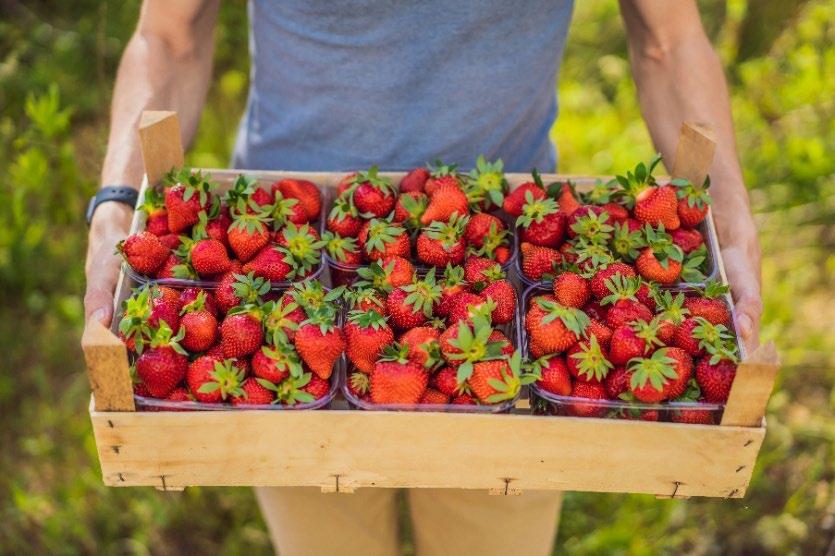
This material is based upon work supported by the National Institute of Food and Agriculture and the U.S. Department of Agriculture (USDA), award number 2020-38640-31523 through the Western Sustainable Agriculture Research and Education program under project number SW21-923. The USDA is an equal opportunity employer and service provider. Any opinions, findings, conclusions, or recommendations expressed in this publication are those of the author(s) and do not necessarily reflect the view of the USDA.
References
Cappelli, L., D’Ascenzo, F., Ruggieri, R., & Gorelova, I. (2022). Is buying local food a sustainable practice? A scoping review of consumers’ preference for local food. Sustainability, 14(2), 772. https://doi.org/10.3390/su14020772
Darby, K., Batte, M. T., Ernst, S., & Roe, B. (2008). Decomposing local: A conjoint analysis of locally produced foods. American Journal of Agricultural Economics, 90(2), 476–486.
Grebitus, C., Lusk, J. L., & Nayga Jr, R. M. (2013). Effect of distance of transportation on willingness to pay for food. Ecological Economics, 88, 67–75.
Gundala, R. R., & Singh, A. (2021). What motivates consumers to buy organic foods? Results of an empirical study in the United States. PLoS One, 16(9). https://doi.org/10.1371/journal.pone.0257288
LaMotte, S. (2024). Blueberries, strawberries again on the ‘dirty dozen’ list. CNN Health. https://www.cnn.com/2024/03/19/health/dirty-dozen-produce-pesticides-2024-wellness
Langford, M., Curtis, K., & Pignatari, M. (2024). Utah consumer preferences and willingness to pay for specialty labeled fruit products [Fact sheet]. Utah State University Extension.
Loebnitz, N., & Aschemann-Witzel, J. (2016). Communicating organic food quality in China: Consumer perceptions of organic products and the effect of environmental value priming. Food Quality and Preference, 50, 102–10.
McCurdy, M. (2022, May 17). Health benefits of eating locally [Fact sheet]. University of New Hampshire Extension. https://extension.unh.edu/blog/2022/05/health-benefits-eating-locally Yazdanpanah, M., Forouzani, M., & Hojjati, M. (2015). Willingness of Iranian young adults to eat organic foods: Application of the Health Belief Model. Food Quality and Preference, 41, 75–83.
In its programs and activities, including in admissions and employment, Utah State University does not discriminate or tolerate discrimination, including harassment, based on race, color, religion, sex, national origin, age, genetic information, sexual orientation, gender identity or expression, disability, status as a protected veteran, or any other status protected by University policy, Title IX, or any other federal, state, or local law. Utah State University is an equal opportunity employer and does not discriminate or tolerate discrimination including harassment in employment including in hiring, promotion, transfer, or termination based on race, color, religion, sex, national origin, age, genetic information, sexual orientation, gender identity or expression, disability, status as a protected veteran, or any other status protected by University policy or any other federal, state, or local law. Utah State University does not discriminate in its housing offerings and will treat all persons fairly and equally without regard to race, color, religion, sex, familial status, disability, national origin, source of income, sexual orientation, or gender identity. Additionally, the University endeavors to provide reasonable accommodations when necessary and to ensure equal access to qualified persons with disabilities. The following office has been designated to handle inquiries regarding the application of Title IX and its implementing regulations and/or USU’s non-discrimination policies: The Office of Equity in Distance Education, Room 400, Logan, Utah, titleix@usu.edu, 435-797-1266. For further information regarding non-discrimination, please visit equity.usu.edu, or contact: U.S. Department of Education, Office of Assistant Secretary for Civil Rights, 800-421-3481, ocr@ed.gov or U.S. Department of Education, Denver Regional Office, 303-844-5695 ocr.denver@ed.gov. Issued in furtherance of Cooperative Extension work, acts of May 8 and June 30, 1914, in cooperation with the U.S. Department of Agriculture, Kenneth L. White, Vice President for Extension and Agriculture, Utah State University. July 2024 Utah State University Extension.

June 2025
Utah State University Extension
Peer-reviewed fact sheet
